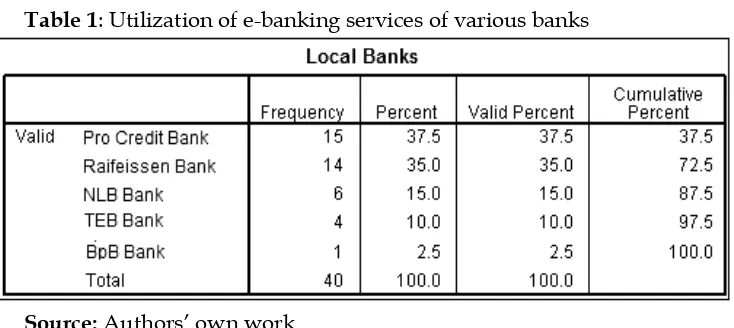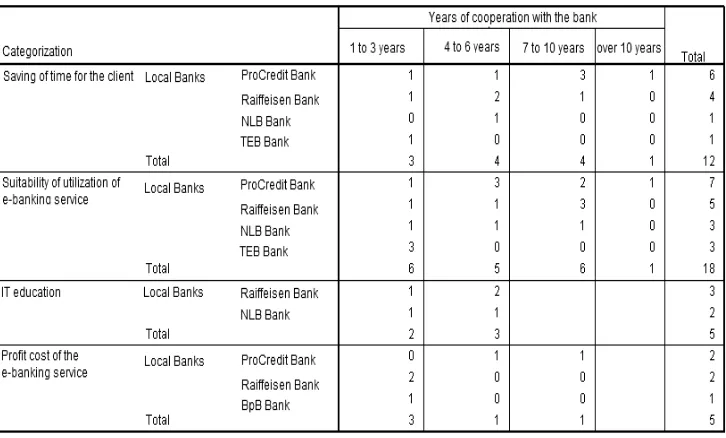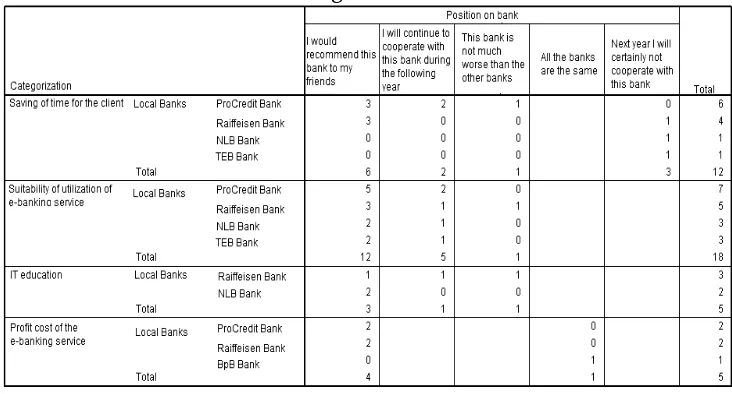Abstract
There is a visible demand to increase the awareness for the efficacy and the advantages that e-banking has to offer to small enterprises; however, many other enterprises cannot conceive the possibility of running their business without e-banking. This study on approach of local firms towards e-banking is conducted by applying the Grounded Theory of Barney Glaser and Anselm Strauss and the Critical Incident Technique, in order to identify the factors influencing the satisfaction of the business clients when using e-banking services. The empirical data were gathered through interviews. Factual findings establish the foundation for a more extended research aiming to reveal the satisfaction of the business clients with service of e-banking, simultaneously exploring opportunities which banks have to adopt in order to succeed in attracting and retaining the business clients.
Key Words: e-banking, adaptability, satisfaction, time saving, local firms.
1. Introduction
E-banking represents a new functional approach that enables its clients of a given financial institution to perform financial transactions through a secure website which is
MSc. V. MULLATAHIRI, MSc. L. ABDULLAHU,
MSc. G. PODVORICA
The Approach of Local Firms towards
E-Banking
operated by that institution. E-banking offers new advantages and possibilities for all business and individual clients such are: time saving, given that the physical presence is not required in order to perform the transfer; reduction of transaction cost; fast access to account (at all time and from any location); the possibility of comparing the data, e.g. offers, bank statements, etc.
In Europe and in USA one observes an ever increasing trend of the volume of transactions performed through e-banking, whereas in Kosovo we still do not have the exact statistical data on the usage and implementation of e-banking. In European countries, in average 40% of the people use the bank services through internet. E-banking is a highly widespread in Nordic countries and in Netherlands, where over 75% of the people use the internet to utilize banking services (OECD, 2015). Currently, e-banking services in Kosovo are used by the small, medium and large enterprises, by various local and international nongovernmental organizations as well as by various educational and health provider organizations.
The aim of this research is to identify the critical dominant incidents and main stimulants (efficacy, security, profit for the clients, or the issues that might be alarming for a given bank) that have impact and influence on the behaviour in using or not using e-banking services by the business clients; to analyse factors that challenge utilization of e-banking and to create a background profile regarding the behaviour of business clients toward e-banking services.
Research methodology applied is based on the grounded theory of Barney Glaser and Anselm Strauss (Glaser and Strauss, 2005) and on the Critical Incident Technique (Flanagan) thanks to which technique one can observe the positive and negative factors that influence the usage of e-banking services by the enterprises in Kosovo.
The data analysis process consists of three parts; data presentation, coding process (open coding, axial coding and selective coding) (Charmaz, 2006) and the interpretation of findings followed by the conclusions.
2. Methodology of Qualitative Research
As a basis for data gathering we have utilized the Grounded Theory whereas in order to perform the data analysis and identification of key factors, we have utilized the Critical Incidents Technique.
The method of Grounded Theory is a general research method invented by sociologists Glaser and Strauss. This method offers guidence on matters of data collection, coding and analyzing. It finds usability in qualitative same as in quantitavie data collection of any type. It is a research tool that enables you to seek out and conceptualise the latent social patterns, and structure the areas of interest through a process of constant comparison (Groundedtheoryonline.com, 2015).
In the social science this method it is also known as a systematic methodology aiming to reach a revealing theory through synthesizing of the data. This method is invented by two sociologists Glaser and Strauss, who by performing a study in a hospital showed that; the type of the awareness among patients and hospital staff had a significant impact on their interaction. This way they developed a comparison method to which we refer today as Grounded Theory, which is presented in a book named: Awareness of Dying by (Glaser and Strauss, 2005). Although in most of the cases this method is utilized in qualitative research the same method is also applicable for quantitative researches by offering the ground in discovering a theory (Glaser and Strauss, 1967) rather than raising hypothesis. This method is a systematic research in gathering and analysing qualitative data whose aim is to generate a descriptive theory.
For data analysis, with the objective to analyse the relationship bank-client during e-banking, we have utilized the Critical Incident Technique. This technique is a series of procedures for data collection through direct observation of human behaviour that have a critical significance. These observations are then kept track of as incidents, which are then used to solve practical problems and develop broad psychological principles.
codes in one group. When we have a set of groups we get out the key concepts, out of which, in the end one can establish categories to analyse and reach conclusions.
In other words Critical Incident Technique offers empirical basis to solve practical problem and enables the researcher to develop wide-ranging psychological principles for drafting concepts based on which we are able to understand important phenomena that influence the area being studied (Rexha, 2013). Through this technique one obtains the general information on the management or the working procedures by concentrating on the particular critical incidents.
2.1 Collection Of Data
Data collection is conducted through interviews performed with 63 representatives of small and medium enterprises, trading and service provision firms, nongovernmental and international organizations in the municipality of Pristine, all of which utilize e-banking in their daily business. The selection of the interviewees is done through a random method.
In cases where one did not utilize e-banking, the interviews lasted 5 minutes, whereas in the cases where one utilized e-banking, the interviews lasted for up to an hour.
Out of 63 performed interviews on site, 23 of the interviewees declared that they do not utilize e-banking, therefore the latter cases were not dealt with in this study. The valid empirical data were processed through the statistical analysis software – SPSS.
3. Interpretation and Data Analysis
Table 1: Utilization of e-banking services of various banks
Source: Authors’ own work
Among the overall number of interviewees that utilize e-banking (see table 2), 45% of them state that their critical incidents refer to Suitability of utilization of e-banking service which at the same time represents a label in selective coding; 30% of the interviewees state that their critical incidents refer to Time Saving (second label of selective coding); 12.5% of the interviewees relate their incidents to the Profit Cost of Utilization (third label of selective coding) of e-banking, and 12.5% of interviewees state that their critical incidents refer to the Need for information technology training (fourth label of selective coding).
Table 2: Categorization of labels
As a result of our interviews one observes that 35% of business clients cooperate with banks in a time period stretching from 1-3 years, 32.5% of business clients cooperate with banks in a period stretching from 4-6 years, 27.5% cooperate with banks 7-10 years, whereas only 5% of business clients cooperate with banks for a period longer than 10 years (see Table 3).
Table 3: Years of cooperation with bank
Source: Authors’ own work
Table 4: Position of business clients on bank
Source: Authors’ own work
The age of the interviewees form an important part of the interview and from the data it derives that 50% of the interviewees that use the e-banking are from 18 to 35 years of age, whereas 45% are from 36 to 45 years of age, only 5% of interviewees are over 46 years of age (see table 5).
Table 5: The age of interviewees
Source: Authors’ own work
Table 6: Profession of interviewees
Source: Authors’ own work
Based on this we can conclude that the e-banking services are mostly used by the responsible persons tasked with managing the finances and accounting and who are also responsible for performing bank transfers.
Based on table 7, one can clearly see that 30% (or 12) of the interviewees consider that e-banking service saves time, 66.7% of them have over 4 years of experience with these banks, they also state to have very good experience with these banks, as a result of which they would recommend or they will work in the future with these banks (ProCredit Bank and Raiffeisen). In this particular case, the years of cooperating with banks indicate the satisfaction of client with the e-banking service and at the same time it indicates that early adopters of e-banking service usually are the clients of ProCredit and Raiffeisen bank.
Table 7: Interconnection among categorization, banks and years of cooperation
Source: Authors’ own work
In general the new services in market, including e-banking services are not easily adopted due to the hesitation and the education of clients. The data from our research indicate the same, 12.5% of the interviewees confirm the fact that IT Education in our country continues to be a problem and the reason for not utilizing new services. These cases were present in the first years of cooperation with the bank, from 1-3 years and 4-6 years, which indicate that with continuing exercise of the service, this problem is thus eliminated.
Therefore, the banks should pay attention to the promotion of e-banking service and at the same time they should design user-friendlier platforms in order to eliminate the problems that derive as a result of the lack of IT education, which would increase the number of users.
Whereas regarding the position of clients (see table 8) regarding the banks, one deduces that due to the factor of saving time, 6 clients state that they would recommend the bank to their friends, 2 state that they would continue the cooperation for the following year and one case was of neutral stance regarding the service and that their bank is not much different from others. Based on these results the “saving of time” represents the core value of e-banking service which has positive and negative effect on relationship between the client and the bank.
Table 8: Interlink between categorization, banks and statements
Source: Authors’ own work
Similarly with the topic of suitability, 12 occurrences indicate that it is this exact practical reason and suitability in utilization of e-banking service the reason why they would recommend these banks and why they would continue cooperating with them. There is no registered occurrence which indicates that they would not continue cooperating with the bank or that they consider the service the same due to suitability reasons.
the same as the others. Nevertheless, the very fact that one registered as a topic the issue of “IT education” indicates that both banks and clients need to work in this area (through the promotion of the services and education at the same time) and that there is space within which one can manoeuvre, the latter could be used by banks as a comparative advantage.
Regarding the profit cost, there are 4 instances that the respondents declare that it is due to the cost that they would recommend the bank to their friends. Only one case indicates that all the banks are the same. There is no case that is interlinked with three other statements. This indicates that in the end of the day, it is the cost of service the single most critical issue that bears most of the weight in shaping the convictions and impressions regarding the values and gains from a certain service. Therefore, the banks need to pay additional attention to the cost of services they provide, in order to meet the expectations of their clients.
4. Conclusions and Recommendations
4.1 Conclusions
As a conclusion of this research paper: “The suitability of the e-banking services” is highly valued by all the business clients due to the fact that it helps the fast decision-making, it reduces the occurrence of errors and it offers the possibility of performing the transfers at any given time. On the other hand, the clients that value suitability, they request that e-banking service platforms are rendered more user-friendly, to offer higher level of security and to obtain instant confirmation regarding the performed transfers.
“Saving of time” represents a highly important factor for business clients who use the e-banking services. It the businesses to operate in a more time vice efficient manner, without having to lose time in long queues, to become more competitive, to avoid possible errors which can occur during the procedures of transfer at the bank counters. On the other hand, due to weak internet link, the transfers that take place through e-banking are slow, which attest the fact that e-banking services need to be suitable for business clients.
related costs that affect the service itself as well as the importance of cooperation bank-consumer.
“Education” of the bank officials and business clients plays an important role in utilization of e-banking service. If the bank officials do not have appropriate knowledge to maintain the e-banking service platforms, if they do not promote or advice the clients on how to utilize the e-banking services, then these services for clients who have attained lower education will be rendered difficult to be used. In the end, all the findings evolve around the suitability of utilization of e-banking services, saving of time for the clients and savings on bank resources.
4.2 Recommendations
E-banking services can play a crucial role on influencing customer to adapt services of one particular bank from another and this as a consequence in return can bring huge payoffs. As the survey revealed in order to increase the number of their clients, the banks should design a more user-friendly platforms, in addition the same should be more secure that with possibility of instant verification for performed transfers.
The further development of the E –banking services offers banks a chance to change their market position, at the same time is a better chance to improve their profit and reduce operational expenses. Banks shall promote their services more, by applying all means of promotion, including advertisements, events and experiences of other clients, audio-visual materials, on-call assistance services and social media.
Banks should conduct individual researches on designing a more user-friendly (web based) platforms. These platforms shall be convincing and a special care should be given to the security of transactions, users should be served in a dynamic way without interruption. If for some reason something goes wrong with a particular transaction there should be means available to immediately correct the damage and acknowledge it.
List of References
Charmaz, Kathy. 2006. Constructing Grounded Theory. London: Sage
Publications.
Flanagan, John Clemans. The Critical Incident Technique. [Washington: American Psychological Association].
Glaser, Barney G, and Anselm L Strauss. 2005. Awareness Of Dying. New Brunswick, NJ: Aldine Transaction.
Glaser, Barney G, and Anselm L Strauss. 1967. The Discovery Of Grounded Theory. Chicago: Aldine Pub. Co.
Glaser, Barney Galland, and Anselm L Strauss. 2005. Grounded Theory. Bern: Huber.
Groundedtheoryonline.com, 2015. 'What Is Grounded Theory? - Grounded Theory Online; Supporting GT Researchers'.
http://www.groundedtheoryonline.com/what-is-grounded-theory. Groundedtheoryreview.com, 2015. 'Grounded Theory Review An
International Journal'. http://groundedtheoryreview.com/wp-content/ uploads/2012/06/GT-Review-vol-9-no-21.pdf.
Rexha, Nexhmi. 2013. 'Udhezues Per Hartimin E Projektit Kerkimor'.
Metodologjia E Kerkimit..


